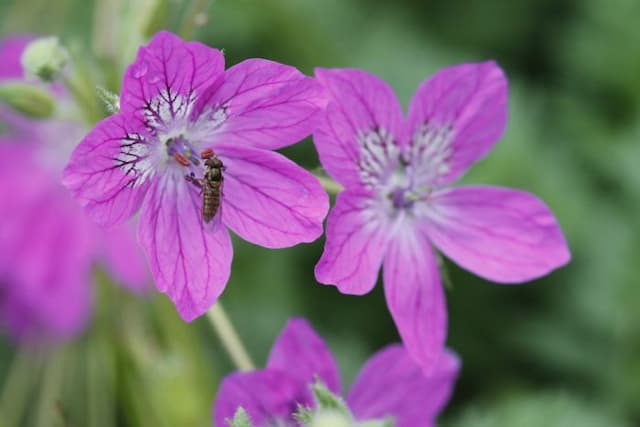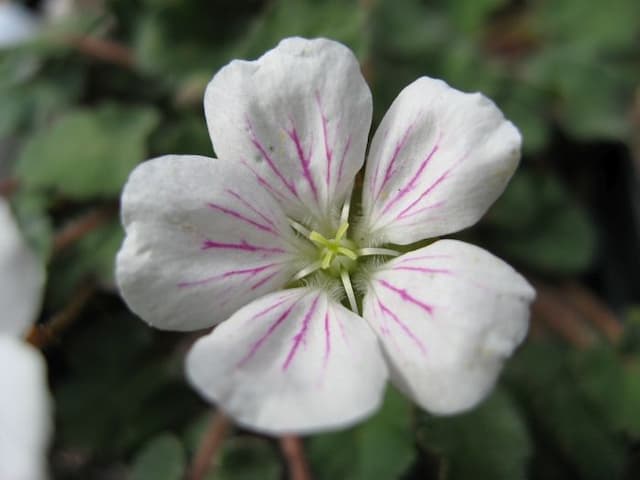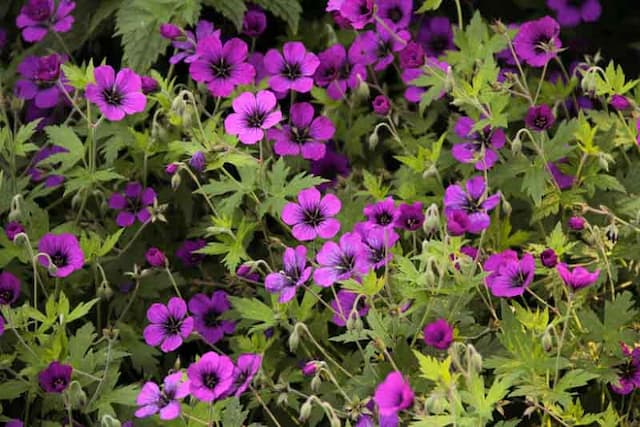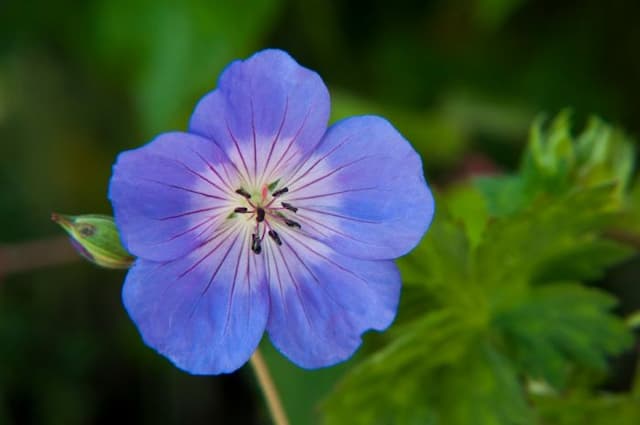Bloody cranesbill Geranium sanguineum 'Belle of Herterton'

ABOUT
The Geranium sanguineum 'Belle of Herterton', commonly known as the bloody cranesbill, is a delightful perennial plant characterized by its vibrant and attractive appearance. The plant features striking flowers that are an intense magenta-pink in color, drawing the eye with their bold hue and intricate details. Each flower is rounded, composed of five petals that exhibit delicate veining patterns, enhancing their ornamental quality. The foliage of the bloody cranesbill 'Belle of Herterton' adds to its charm with deeply lobed leaves that provide a lush, textured backdrop for the bright blooms. The leaves are typically a rich green, creating a nice contrast against the flowers, and may turn to reddish hues in the fall, adding further seasonal interest. The overall form of the bloody cranesbill is that of a dense, mounding clump, giving it a neat and tidy appearance in the garden. This habit makes it an excellent choice for border fronts, rock gardens, or as ground cover where its ornate flowers and foliage can be displayed to full effect. Throughout the blooming period, which lasts from late spring to early summer, the 'Belle of Herterton' becomes a hub of activity for pollinators such as bees and butterflies, enhancing the plant's garden value both aesthetically and ecologically. Once established, it remains resilient and relatively low maintenance, capable of flourishing in a variety of garden conditions and climates.
About this plant
 Names
NamesFamily
Geraniaceae.
Synonyms
Bloody Cranesbill, Bloody Geranium.
Common names
Geranium sanguineum 'Belle of Herterton'.
 Toxicity
ToxicityTo humans
The plant commonly known as Bloody Cranesbill is generally considered non-toxic to humans. There are no well-documented cases of poisoning from ingesting Bloody Cranesbill, and thus typical symptoms of poisoning are not described for this plant. However, as with any plant, individual allergies or sensitivities could possibly result in mild gastrointestinal upset or dermatological reactions for some people.
To pets
Bloody Cranesbill is also considered non-toxic to pets. Ingesting parts of this plant should not cause any significant symptoms of poisoning in pets such as dogs and cats. As always, while it is not expected to be harmful, monitoring pets after ingestion of any plant material is wise in case of unexpected reactions, such as mild gastrointestinal discomfort.
 Characteristics
CharacteristicsLife cycle
Perennials
Foliage type
Deciduous
Color of leaves
Green
Flower color
Pink
Height
0.5 feet (15 cm)
Spread
1 feet (30 cm)
Plant type
Herb
Hardiness zones
5
Native area
Europe
Benefits
 General Benefits
General Benefits- Attracts Pollinators: Geranium sanguineum 'Belle of Herterton', commonly known as Bloody Cranesbill, attracts bees and butterflies, promoting pollination in the garden.
- Low Maintenance: This variety of Bloody Cranesbill is known for being hardy and requiring minimal care once established, making it ideal for gardeners looking for low-maintenance plants.
- Drought Tolerance: Once established, it can tolerate periods of drought, reducing the need for frequent watering.
- Ground Cover: Its mat-forming growth habit helps it spread across the ground, providing an excellent cover that reduces weed growth.
- Aesthetic Appeal: With its bright pink flowers and attractive foliage, Bloody Cranesbill adds color and texture to garden borders, rockeries, and containers.
- Erosion Control: Its dense growth can help stabilize soil and prevent erosion on slopes or in areas prone to washing out.
- Seasonal Interest: This plant provides a long blooming season from spring to summer, offering prolonged visual interest in the garden.
- Wildlife Friendly: Beyond pollinators, the plant also provides habitat and potential food sources for other wildlife like certain insects and birds.
- Adaptability: Geranium sanguineum 'Belle of Herterton' adapts well to a wide range of soil conditions, from clay to sandy soils, as long as they are well-drained.
 Medical Properties
Medical Properties- This plant is not used for medical purposes.
 Air-purifying Qualities
Air-purifying QualitiesThis plant is not specifically known for air purifying qualities.
 Other Uses
Other Uses- Geranium sanguineum, or bloody cranesbill, can be utilized in natural dyeing processes, where different parts of the plant, such as leaves and flowers, may yield a variety of subtle colors.
- These plants can be integrated into wildlife gardens, providing a habitat and nectar source for beneficial insects like bees and butterflies, thus supporting local biodiversity.
- The flowers and foliage offer decorative elements for culinary presentation, where the petals could add a splash of color to salads or desserts, although they are not widely recognized as an edible garnish.
- Geranium sanguineum 'Belle of Herterton' can be used in potpourri mixtures, as the foliage retains its fragrance when dried.
- In craft projects, the leaves and flowers can be pressed and preserved to create botanical artworks or to embellish handmade paper.
- The plant can serve as a ground cover in ornamental landscaping, providing erosion control on sloped areas due to its mat-forming growth habit.
- Bloody cranesbill can be planted as part of a green roof system, where it can contribute to insulation and stormwater management due to its hardy and low-maintenance nature.
- The low-growing characteristic of Geranium sanguineum makes it ideal for use as an edging plant along paths or flower beds, providing a neat and compact border.
- In container gardening, particularly in balcony gardens, this plant can be showcased to add color and texture due to its attractive foliage and vivid flowers.
- Education and horticultural therapy settings might use this plant to teach about native species, pollination, and the importance of preserving plant varieties.
Interesting Facts
 Feng Shui
Feng ShuiThe Bloody Cranesbill is not used in Feng Shui practice.
 Zodiac Sign Compitability
Zodiac Sign CompitabilityThe Bloody Cranesbill is not used in astrology practice.
 Plant Symbolism
Plant Symbolism- Good Health: Geraniums, in general, are often associated with health and vitality. Their vibrant colors and robust growth are symbolically linked to a healthy life or recovery from illness.
- Friendship: Offering a geranium plant like 'Belle of Herterton' can signify a wish for deeper friendship or convey feelings of esteem and affection.
- Happiness: The bright and cheerful flowers of the geranium are believed to represent happiness and positive emotions, making them a common gift to uplift spirits.
- Peace: The geranium can also symbolize peace and tranquility, suggesting its presence can help create a calm and serene environment.
- Fertility: In some cultures, geraniums represent fertility and creation, possibly because of their abundant growth and proliferation.
 Water
WaterThe Bloody Cranesbill should be watered deeply once a week, providing about 1 inch of water at each session. During hot or dry spells, you might need to water twice a week, ensuring the soil remains evenly moist but not waterlogged. Adjust watering during rainy periods to prevent overwatering. If you're using a container, water until excess moisture drains out from the bottom. It's crucial to avoid letting the plant dry out completely, as this can stress the Bloody Cranesbill and lead to wilting.
 Light
LightBloody Cranesbill thrives best in full sun to partial shade conditions. It should be placed in a spot where it can receive at least 6 hours of sunlight daily. An east or west-facing garden that enjoys the morning or late afternoon sun is ideal. Ensure the plant is protected from the intense midday sun which can cause the leaves to scorch, particularly in hotter climates.
 Temperature
TemperatureBloody Cranesbill prefers temperatures ranging between 60°F and 75°F for optimal growth. It can survive minimum temperatures down to 20°F, making it suitable for many temperate regions. However, during extreme cold, the plant may die back and then return in the spring. The ideal temperature range should be maintained to encourage steady growth and flowering.
 Pruning
PruningPruning the Bloody Cranesbill can encourage bushier growth and more flowers. It's best to prune in late winter or early spring before new growth begins. Remove dead or damaged foliage and cut back up to one-third of the plant to promote fresh growth. After the first flush of flowers, lightly prune to deadhead and stimulate a second bloom in late summer or fall.
 Cleaning
CleaningAs needed
 Soil
SoilFor the Bloody Cranesbill, a well-draining soil mix is ideal, composed of loam, peat, and sharp sand in equal parts. The preferred soil pH should be in the range of 5.8 to 6.8.
 Repotting
RepottingBloody Cranesbill does not need frequent repotting and can typically be repotted every 2 to 3 years to refresh the soil and accommodate growth.
 Humidity & Misting
Humidity & MistingBloody Cranesbill thrives in average room humidity levels; there is no need for special humidity adjustments.
 Suitable locations
Suitable locationsIndoor
Place in bright, indirect light and water when topsoil dries.
Outdoor
Plant in partial shade, well-draining soil, and water regularly.
Hardiness zone
4-8 USDA
 Life cycle
Life cycleGeranium sanguineum 'Belle of Herterton', commonly known as bloody cranesbill, begins its life cycle as a seed, which, when sown, germinates under proper warmth and moisture conditions. The seedling emerges, developing into a young plant with characteristic lobed leaves and begins to establish a root system. As it matures, the bloody cranesbill produces distinctive pink to purplish flowers during late spring and summer, which are pollinated by insects, leading to the formation of seed capsules. After pollination and seed development, the plant disperses its seeds, ensuring the propagation of the next generation. During autumn, the foliage often turns bright red, adding ornamental value to the garden before the plant enters a period of dormancy in winter. This perennial herbaceous plant then resumes growth from its overwintering rootstock with the onset of spring, repeating its life cycle.
 Propogation
PropogationPropogation time
Spring-Early Summer
The Geranium sanguineum 'Belle of Herterton', commonly known as Bloody Cranesbill, can be propagated chiefly through division, which is the most popular method for this species. The optimal time to divide these plants is either in spring or autumn, when the plant is not in full flower and its growth is beginning to resume or slow down. To propagate by division, you would begin by carefully digging up the plant, ensuring you have a good amount of root and plant material. The next step is to gently tease apart the roots and divide the clump into smaller sections, each section should contain at least one growing shoot. Finally, you would replant the divisions at the same depth they were originally growing and water thoroughly, spacing them about 12 to 15 inches (approximately 30 to 38 centimeters) apart to allow enough room for growth. This method ensures the new plants will be true to the parent plant since they are genetically identical.






![Cranesbill [Rothbury Gem]](/_next/image?url=https%3A%2F%2Fplants-admin.emdemapps.com%2Fimages%2Fplants%2F%2Fimages%2F604b6243984c2.png&w=640&q=75)


